Wondering what to pack for our trip to the Swedish Arctic?
In this article you’ll find an intro to the weather in the Arctic at the end of March and beginning of April and a handy list of suggestions for things to bring.
Generally speaking, this is a transition period between winter and spring, so the weather can be very variable from day to day and even from day to night.
It could be sunny and above freezing or windy and snowy, and well below freezing. It could also be both kinds of weather in a week-long trip.
See our Amazon Swedish Arctic winter packing list with all the product recommendations mentioned here.
The weather in the Swedish Arctic in April

April is the month of change between winter and spring and while the days are already quite long and temperatures rise quickly, you can easily experience four seasons in a day.
It is a lovely month to visit because it is one of the quietest. Snow should still cover most forests and landscapes, but the sunshine brings on clear blue skies on most days.
Snowfall is still pretty common and the Northern Lights are still visible because of how far north you are.
I spent a week between Lulea and Kiruna during the first week of April and enjoyed the perfect winter weather, with pristine, sparkling snow covering forests and trees, 12cm / 5in falling overnight on my last day, the Northern Lights making an appearance on two of the nights and clean crisp air every day.
Here is what you should expect in terms of weather conditions:
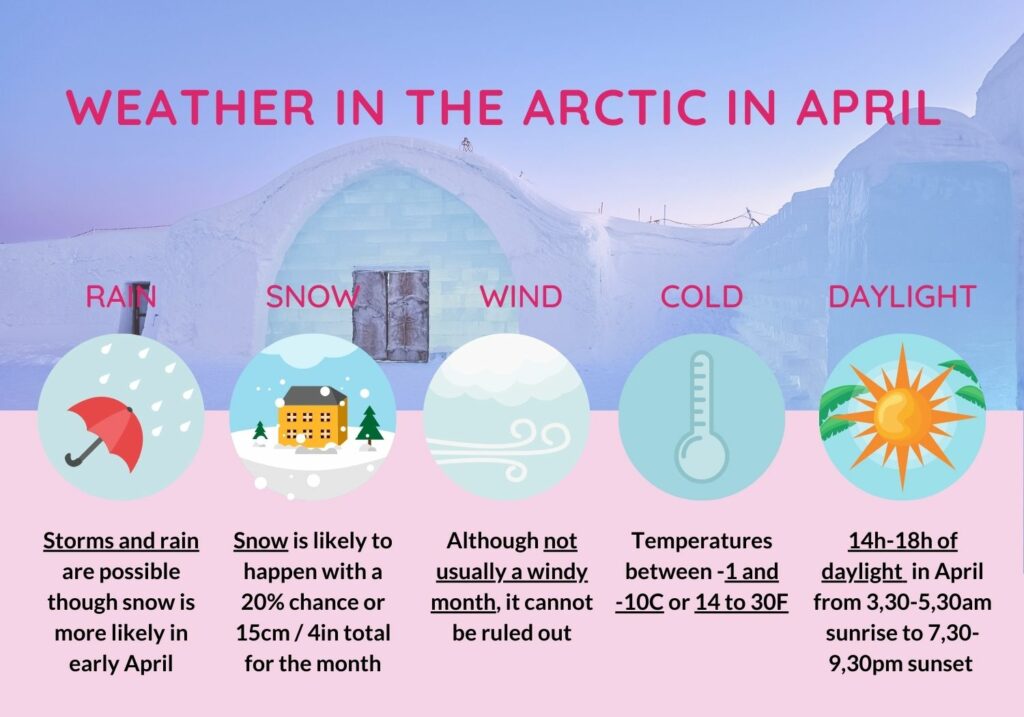
It’s important to realise that there is a huge change in hours of daylight between the beginning and end of the month and that the days are extremely long, so having a proper eye mask to sleep is essential.
During the day, temperatures should be above zero but sudden snowfall can bring them down again. I braved temperatures as low as -27C (-17 F) and heavy snowfall, but the sun was shining most of the time.
What to wear in the Arctic in April
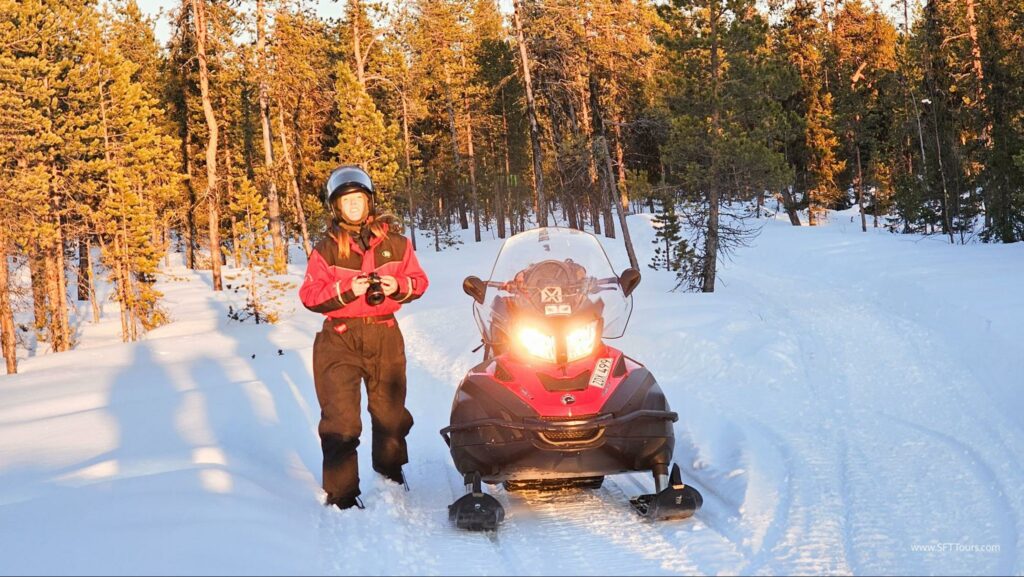
Below is a list with suggestions for what to wear in the Arctic in the winter. Even though April is the beginning of Spring, it is easier to take clothes off than to add on if you didn’t bring them.
The most important factor when deciding what to wear in the Arctic is the concept of layering. This applies to traveling to any cold-weather country, but is particularly important at this time of year when the weather is extra unpredictable.
At a minimum, you need a base thermal layer, a wool sweater and an outer layer that is wind and waterproof (in case it rains). More layers, for example a vest or a short sleeved t-shirt, are not a bad idea either and can be useful if you usually get cold.
Even in posh restaurants (like during our welcome dinner), casual is king and everyone dresses for the weather, especially since many of the hotels we stay at are spread over several buildings so you will have to walk outside on the snow to go to dinner or breakfast.
The other critical consideration after layering is that your outer layers should be waterproof, and, ideally, wind proof. The wind can make temperatures feel like they are 10 degrees lower than what’s shown on the mercury and wind-proof clothing will keep you extra warm.
Last but not least, because all activity providers and hotels in the Arctic know that the weather is extreme and most people don’t have the necessary clothes, they will lend you boots, gloves, hats and even onesies you can wear on top of your regular winter clothes.
For example, the Icehotel and the Arctic Bath Hotel both have technical winter clothes, boots and accessories for guests to borrow. The snowmobile organizers also have clothes you can borrow.
This is the only way you can survive outside on a snowmobile, a dog sled or even just feeding the reindeer when it is -20 C / -4 F outside and you are supposed to spend an hour or longer exposed to the elements.
For this reason, most guests just need to pack regular cold winter gear and borrow more advanced clothing onsite, especially boots that are made for snow, with thick insulated soles.
Thermal base layer
You want to wear a light base thermal layer that is closest to your skin. For this, I highly recommend considering merino wool clothes that repel odors, keep you warm and avoid you getting sweaty from the constant change in temperatures (cold outside, warm inside).
Merino wool clothing is expensive, but it will last you a lifetime. It requires less washing (good for you and for the environment), it is very light (less packing), regulates heat so you sweat less, is natural (rather than made with chemicals) and if it keeps sheep warm in the coldest of weathers, it can keep you warm too!
Clothing made from merino wool is usually sold based on the thickness. The highest thickness you can buy the better in this case. Some of my base layer thermals are 200gr.
I particularly like the Kiwi brand Icebreaker, which is made of sustainable merino wool. I have worn their products in Iceland and other cold / all-weather / windy destinations like the Faroe Islands.
Luckily, they are widely available on Amazon so you should have no issues finding them. They are also often available at outdoor stores.
You should pack both a bottom legging and top merino base thermal layer to put under the rest of your clothes.
Top layer
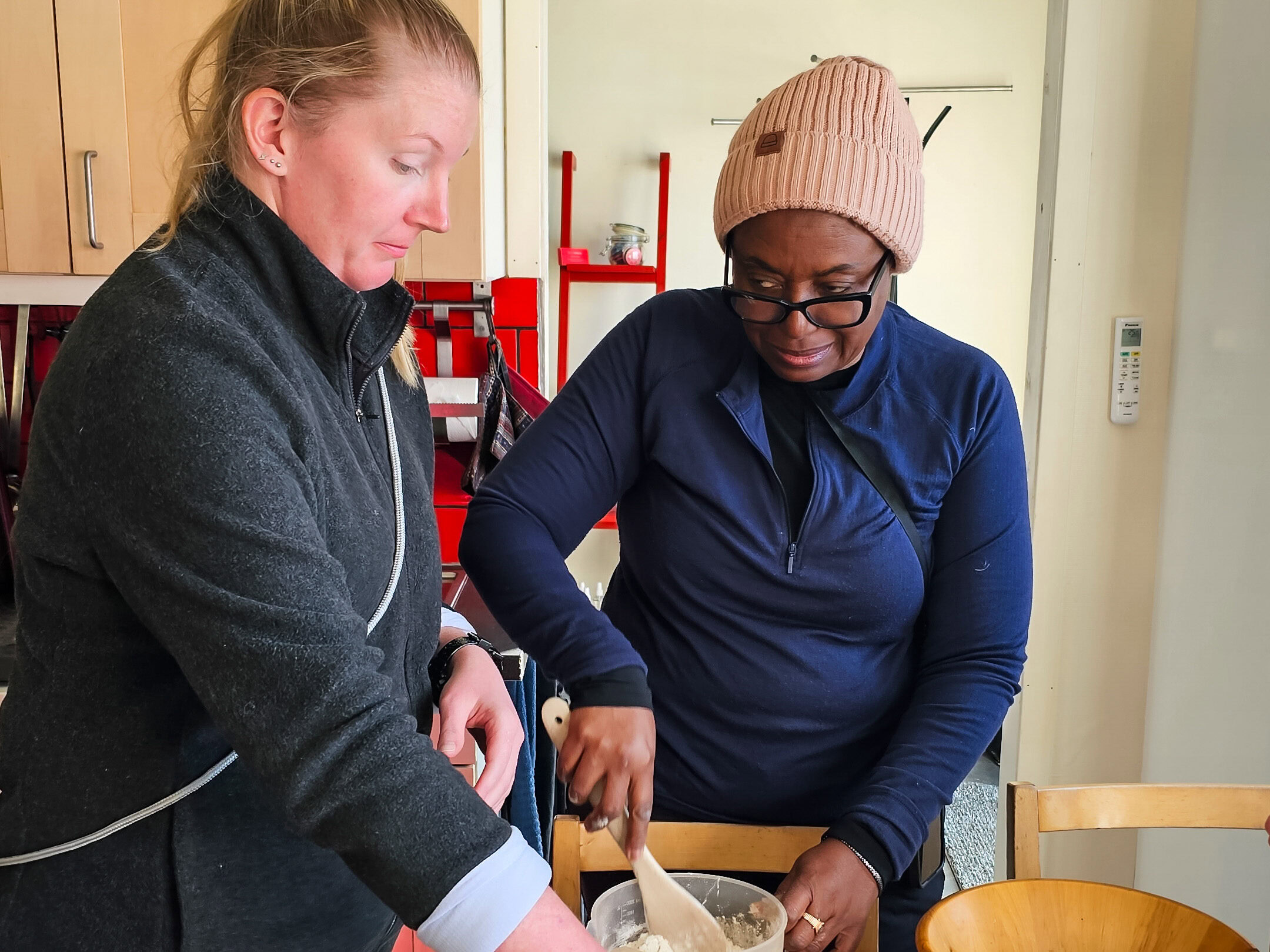
After the base thermal layer, you need a proper sweater or fleece jacket (or both). Scandinavian and Sami people wear thick knitted wool sweaters, like the Icelandic lopapeysa, that you can purchase in winter gear shops or on Amazon. I have one from the Icelandic brand Icewear.
I recommend this layer be high up on the neck to keep you warm, even if you will still wear a scarf on top, nobody likes to get a sore throat.
If you are not a fan of wool, fleece jackets are also a great alternative, soft and thinner while still quite warm.
I particularly like the fact that they have pockets so I can keep small items like lip balm or tissues with me at all times.
Outer layer
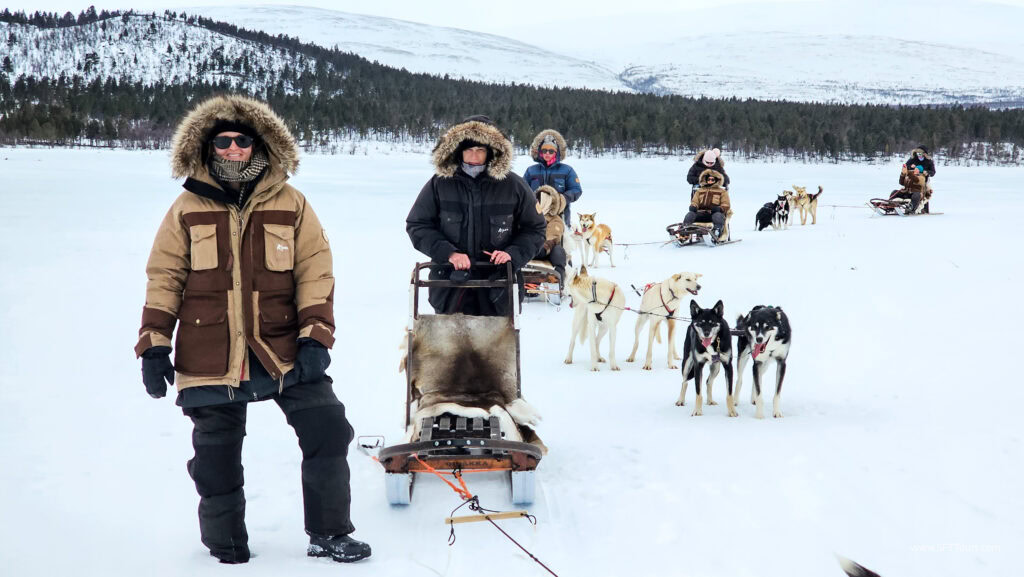
The most important consideration when choosing an outer layer for the Arctic is for it to be warm, waterproof and windproof, and for it to have a hoodie that you can pull over your hat.
Rain is likely, snowfall almost a guarantee, and umbrellas are pointless if you plan to get on a snowmobile or a dog sled. Water resistant clothing is not enough if you are out in the snow or rain for a while, so make sure your jacket is waterproof, or plan to wear a borrowed one.
Everyone has their favorite jackets, but I find that the proper adventure and outdoor brands like Arctix do this best because they are conceived with the needs of a trip to the Arctic in mind.
Look for a jacket that is water and windproof and that comes with a large and warm hoodie like this one. Sky jackets are often a good idea because they are made for the snow and Arctix has several like this one designed for the temperatures you will face in the Arctic.
Additional layers
I always add a couple of tank tops and t-shirts to my suitcase which I wear under the base layer.
I also like to pack a vest, especially those made of fleece, down or wool. These add a layer between the sweater and the jacket while not restricting movement of the arms.
Trousers
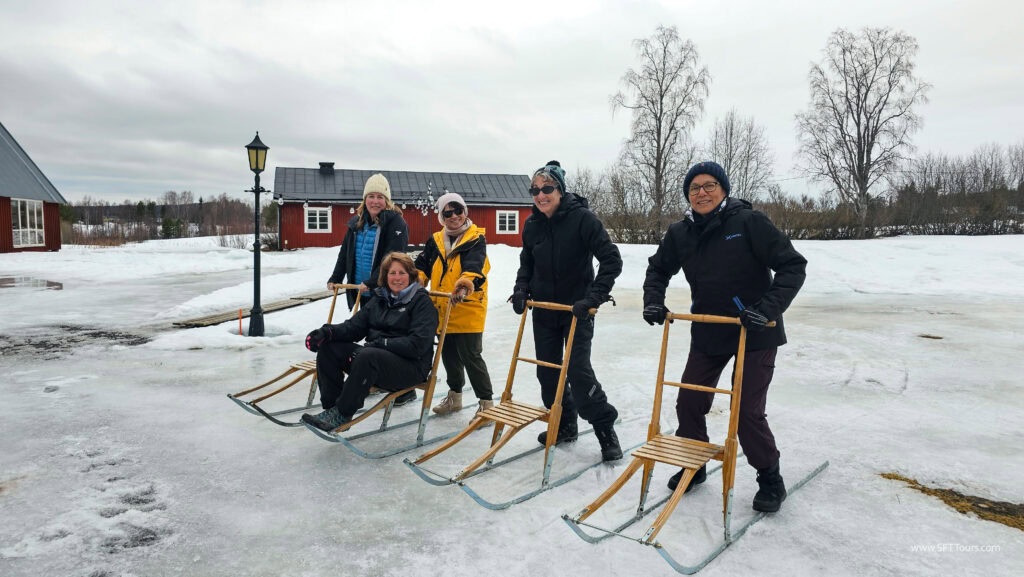
Besides the top layers and jackets, you should also consider bringing warm, waterproof, or at least water resistant or water repellent trousers. Ski pants like these ones from Arctix are best.
When buying these, make sure they are loose enough to fit the base thermal layer.
Besides the waterproof pants, I also recommend packing a lighter pair of trousers, joggers (I have a pair of these ones I wear for travel) or a pair of classic jeans that you can wear to dinner at the hotel and which are less bulky or warm. Inside buildings, it is pretty warm.
This may also be the trousers you wear on the plane on your way to the Arctic if you want to pack light.
Clothing accessories

The clothing accessories you wear are arguably as important as the layers. I recommend you pack a few additional items to stay warm:
- Gloves: You need hardcore winter gloves here or you won’t be able to take your hands out of your pockets, not even to take a photo. I recommend a pair of fleece-lined waterproof gloves like these ones.
- Scarf: Even if you are wearing high neck layers, a merino wool scarf can add that extra warmth and protect your face from the wind chill.
- Hat: Very important to keep your head warm, especially if it starts snowing. I like Icebreakers’ merino wool beanie hats, but I am also partial to the nice knit beanies, especially the fleece or fur-lined ones. Skip the hats with pom poms which may not fit under the hoodie.
- Wool / thermal socks: They will make sure your feet stay warm all the time. I like to pack thick and tall ones that also keep our feet from blistering. I also have a pair of rechargeable heated socks that come with batteries because I struggle to keep my feet warm when I am standing on the snow for long.
- Underwear and sports bras: Since you will be enjoying a relatively active trip, you may want to consider packing sports bras instead of regular wired bras.
- Waterproof bag: If like me, you also prefer to put all your belongings in your pockets, you may not need a waterproof bag. But if you have expensive camera equipment or want to bring more things with you, I recommend packing a waterproof bum bag, a waterproof bag cover to put over yours or a waterproof bag pouch that you can wear around your waist or even inside your jacket. At each of the outdoor activities (snowmobile, dog sled), we will get geared up before heading out and you can leave your valuables behind.
Footwear
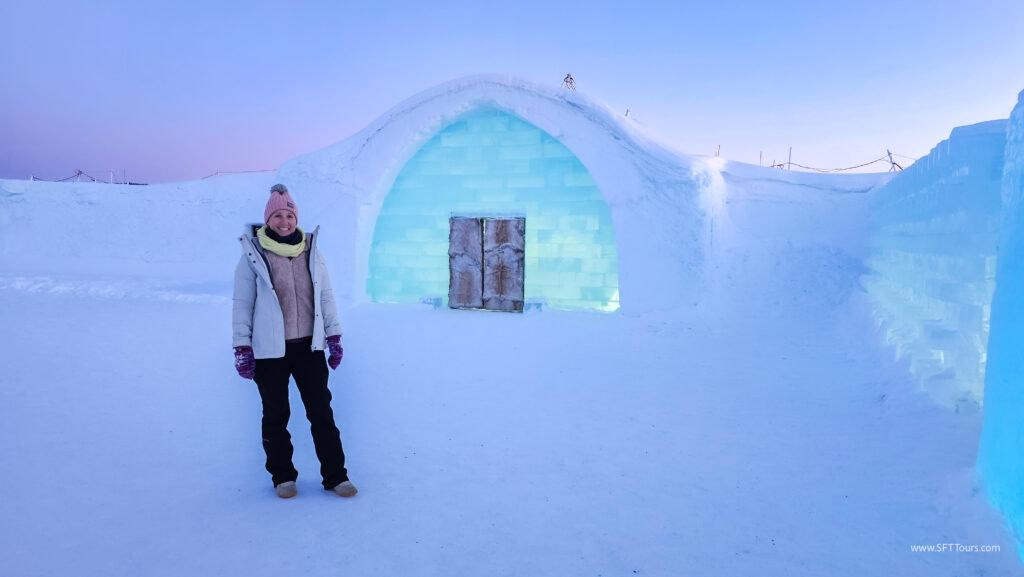
Keeping your feet warm and dry is essential so I recommend you think well about your footwear.
In particular, I recommend wearing a waterproof warm pair of high boots like these ones that many of our guests have used and loved. Alternatively, check out this pair of Columbia snow boots.
As mentioned, the Arctic Bath Hotel, the Icehotel and some of the activity providers will have snowboots you can borrow and wear. However, there will be plenty of times when you won’t be able to borrow boots like when feeding the reindeer, or when going on our foraging excursion.
If you are buying a new pair of boots, I recommend you break them in and wear them out before the trip so they don’t cause blisters. Better yet, consider borrowing a pair from a friend if you don’t think you’ll be using them again.
Bathing suit
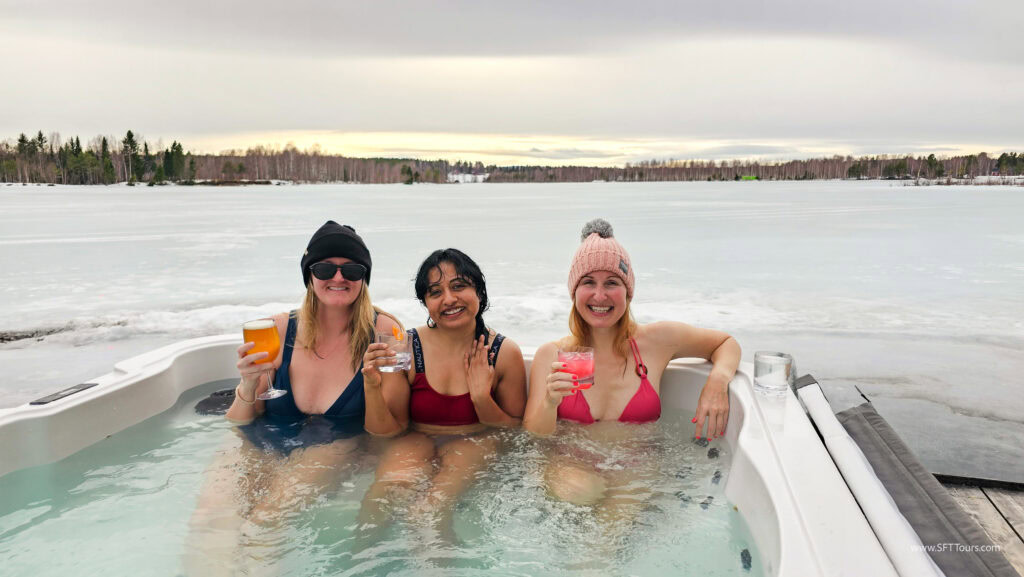
It is very important not to forget your swimming suit for all the sauna and cold plunge opportunities. Almost every hotel in the Arctic will have a sauna and many also have ice plunge options available.
While other sauna facilities could require you to be naked, the ones you will have access to at hotels will require you to wear a swimming suit. Towels will be provided, and you may want to wear your hat to keep your head warm.
Other items you should pack for the Arctic
Besides clothes, there are a few other things you should bring on a trip to the Arctic.
| Hand and feet warmers: These magical inserts work much like the heat pads used in case of an injury only they are much more powerful. You break the liquid inside and stick them to your shoe insoles, and put on thick socks to keep your feet warm for hours. You can also keep some inside your jacket pockets, but make sure not to touch them with bare hands but always with your gloves on. Check these out. Better yet, get these rechargeable ones to minimise waste and not generate as much rubbish. | |
| Universal plug adaptor: Plugs in Europe are two-pronged and round. The best way to ensure you will be able to use any plug is by packing a universal adaptor. I like the ones which come with USB ports so that I can charge phones, cameras and everything else with just one adaptor. I love this one because it has USB ports for all the electronics I now carry. | |
| Power bank: A portable charger can be an essential on long days exploring quaint and charming towns that may not have power outlets readily available everywhere – let alone that your devices may lose battery power faster due to the cold. This Anker Portable Charger has a 20000mAh capacity, and fast-charging USB-C ports, you can power up your devices in a flash, while the LED display keeps you in the know about your battery level. It’s the perfect companion for a day out on the snow when you will be using your phone a lot to take photos and videos and will use up that battery a lot. | |
| Sunglasses: With 14 to 18 hours of daylight at this time of year, the sun can reflect off of any snow and make things brighter than they would normally be, making sunglasses essential for protecting the eyes from harmful UV rays and glare. Try these ones out to protect your eyes in style. | |
| Water bottle: Single use plastic bottles are terrible for the environment so I recommend you bring your own reusable bottle as part of our efforts towards zero-waste and responsible travel. Tap water in Sweden is one of the best in the world and obviously safe to drink. | |
| Sunscreen: One of the most important items in this packing list is sunscreen. The sun is very strong in the winter when it reflects off of snow so protecting your skin is key. I like and use Biore SPF 50++++ for my face because you can wear it under makeup and it is non-sticky and silky smooth. For the body, I highly recommend Aussie brand Sun Bum which is specifically designed for Australia’s super strong sun, is vegan, reef-safe and smells heavenly. They have a travel pack with sizes below 100ml that comes with a pretty pouch and includes sunscreen, lip balm (very important) and aftersun. This is only in the case that you are planning to spend time cold plunging or in the outdoor jacuzzi of the Arctic Bath Hotel for long. | |
| Body lotion: The hotels you will stay at might provide their own and the Arctic Bath Hotel offers a local premium Arctic brand of products in the rooms and with your sauna pack but it might be best to bring your favorite brand. My sister gifted me a Body Shop Christmas Advent calendar that came with many of their products to try and this 96h hydration body butter is amazing. It comes in a flat recycled plastic tub with an aluminum lid that’s super easy for travel and anti-spill (I can testify to that since I’ve traveled a few countries with it). | |
| Lip balm: Lip balm is essential in colder weather to prevent dry and chapped lips. I have recently started using La Neige lip balm and lip mask and it is amazing. | |
| Sleep mask: Although hotels have proper blinds, you will be sharing the room with another traveler who may be a late owl. I strongly recommend the Manta Manta Sleep mask. I have been traveling with it, and wearing it on the plane, for several months now. It is incredibly good at blocking light. One of my most important travel must-haves (PS I have the one with sound incorporated and the one with the cold / warm eye pads). | |
| Pajamas: On our tours, if you book a shared spot, we pair you up with a fellow solo female traveler that we think you’ll get along with – so don’t forget to pack your pajamas! Here’s a comfy choice from Amazon. | |
| Ear plugs: If you are a light sleeper, a pair of ear plugs can help you sleep better. Check these out on Amazon. | |
| First aid kit and medication: Available medications, brands and products in Europe may not be the same as back home, so it’s always best to bring everything you are used to and of course, all prescription medication or vitamins you take. You should also think about packing a basic first aid kit with items such as painkillers, plasters and antiseptic ointment, motion sickness tablets, antihistamines, electrolyte powder etc. See our First Aid Kit list here. | |
| A foldable toiletry bag: I always travel with a foldable toiletry bag which I can hang anywhere. They also help you keep everything easy to find and tidy. This one is very cute and functional! |
